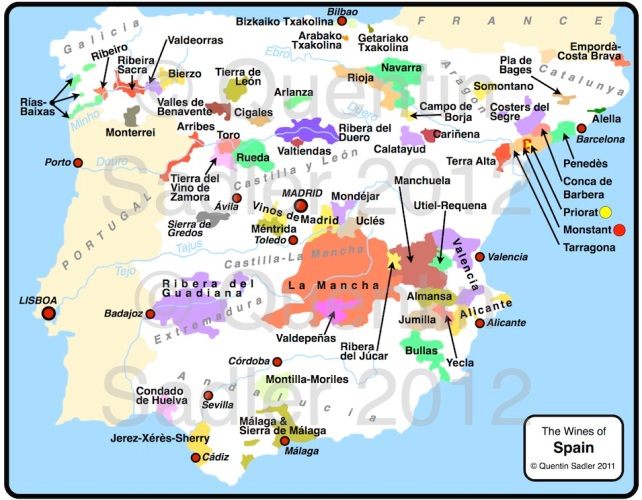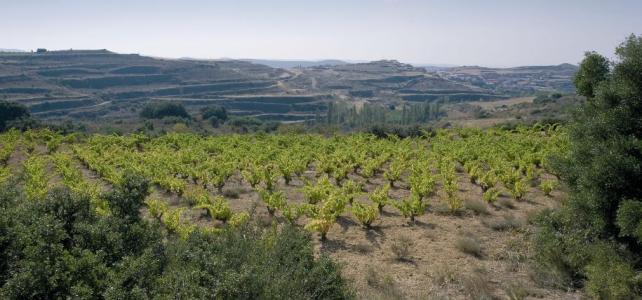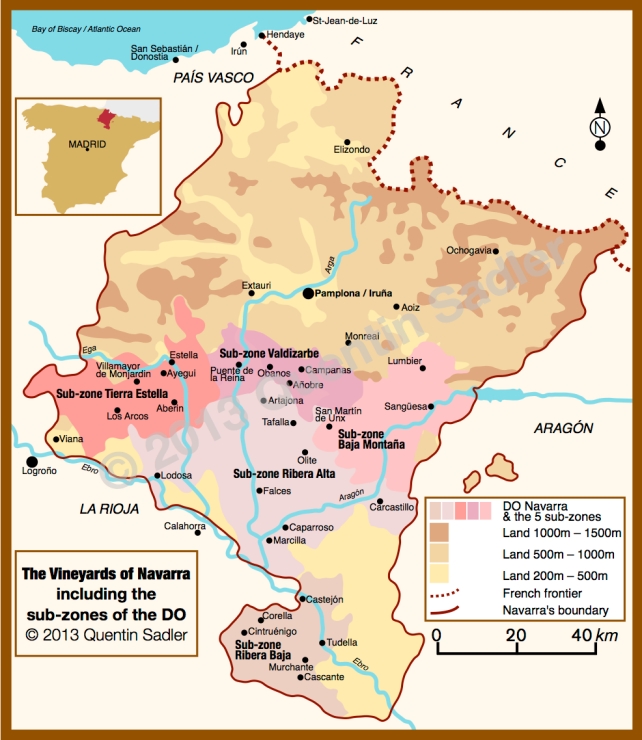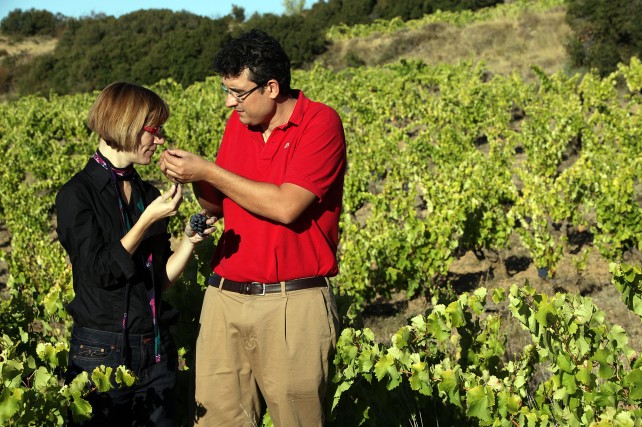I cannot claim to have a favourite grape, let alone one that I drink to the exclusion of all others. I find the less trodden wine paths to be so fascinating that I simply cannot resist lesser known grapes – Carmenère, Zweigelt, St Laurent, Grenache Gris, Nascetta, Romorantin and the like all speak to me and demand their attention. I am never professionally happier or more excited than when experiencing a new grape variety for the first time.
A fine Riesling would probably be my desert island wine of choice as I never seem to tire of that beguiling grape, but for the rest I enjoy a wide spectrum of grapes with very different characters. Regular readers will know though that my passion for all things Spanish often breaks through and trumps my affection for wines from other places, so I think that if push comes to shove Tempranillo might well be my favoured red wine grape – unless I happen to be in a particular Cabernet, Pinot or Syrah sort of mood.

Very different conditions for old vine Tempranillo / Tinto del País in Castilla y León
And why am I so fond of Tempranillo? Well I cannot give you a neat answer to that really, but it speaks to me. Unlike the classic French grapes, which are only grown in specific areas of the country, Tempranillo is used all over Spain and so produces a wide range of wine styles and yet they often seem to be attractive wines to me – the well made examples anyway. Even at quite low price points Tempranillo can be enjoyable to drink.

Tinto Fino in Ribera del Duero
As someone who celebrates diversity in wine it pains me that the differences are being ironed out. Many marketeers seem to believe that wine should be simplified for the UK consumer, even if they have to stretch the truth to do so. Nowadays you are more likely to find Tempranillo on a Spanish wine label from whatever region it hails when to my mind they should have used the old local name: Cencibel in Valdepeñas, Tinto Fino in Ribera del Duero, Tinto del País in Cigales, Tinta de Toro in Toro and the poetic Ull De Llebre in Cataluña. What’s more many people believe these grapes have evolved apart and so are now only very closely related rather than being absolutely identical to Tempranillo – not least the great Carlos Falco, Marqués de Griñon.
It is Tempranillo’s fame as the main grape of Rioja that brings it to most people’s attention, but given Rioja’s popularity it always amazes me how few people grow Tempranillo outside Spain. It has become a dominant grape in Portugal – where it is called Tinto Roriz and Aragonez depending on where you are. There is even some grown in the south of France and I have tasted some from Virginia and Texas and even had one from Peru the other day, but Tempranillo has not yet become a true international grape. The plantings outside Europe remain small and relatively inconsequential, except in Argentina, but even there it is treated as an everyday grape rather than being given the star treatment it deserves. Surely Tempranillo is capable of challenging for Malbec‘s Argentinean throne?

Tempranillo in the softer Tuscan landscape
Perhaps it is this very diversity that I like about Tempranillo? That sense of never knowing quite what you are going to get. As with Bertie Bott’s Every Flavour Beans there is no one flavour to Tempranillo. Some people taste black fruit and some red, some regions produce dry savoury wines from it while other areas make richly fruity examples. Some wine makers craft bright, modern Tempranillos that celebrate fruit and liveliness, while many winemakers stick to the traditional silky, oaky style that made the grape famous in the first place.
Although most famous as the principal grape of red Rioja, Tempranillo – and its near relatives – is also responsible for an array of lovely wines from across Spain and in my opinion it deserves to be as celebrated as much more famous and widely used grape varieties. Which is why I made sure that I tasted some on 8th November which just happened to be International Tempranillo Day:

Wine map of Spain – click for a larger view – non watermarked PDF versions are available by agreement
 2011 Beronia Tempranillo Rosado
2011 Beronia Tempranillo Rosado
Bodegas Beronia, Ollauri, Rioja Alta, D.O.Ca Rioja
100% Tempranillo
The colour is a vivid strawberry juice hue, but it looks like real fruit rather than a confection. The nose is fresh, floral and gently fruity while the palate is dry, rich-ish, crisp-ish, nicely balanced and very nice to drink with almost anything. It won’t win any prizes for complexity, but will make lots of people happy. Spain makes very good rosé, but why isn’t Tempranillo used for more of them? Personally I think it is much more suitable than the more normal Garnacha – 86/100 points
Around £9.00 a bottle in the UK from Ocado.
 2010 Beronia Tempranillo Elaboración Especial
2010 Beronia Tempranillo Elaboración Especial
Bodegas Beronia, Ollauri, Rioja Alta, D.O.Ca Rioja
100% Tempranillo (in Rioja it is traditionally blended with Garnacha and others to make the wines fruitier) aged 8 months in new American Oak barrels.
Deep opaque plummy-black colour.
The nose is fragrant and enticing with spice, vanilla and a touch of mocha.
Pretty full-bodied for Rioja (which despite its reputation is rarely more than medium-bodied) with rich sweet black plummy fruit, fragrant vanilla and dried fruit notes too. The palate is round, rich and succulent with rich cherry on the the end of the mid palate together with a touch of fruit cake and a light dusting of cocoa and coffee and a lovely sinewy texture of gentle tannins and oak. This is a terrific wine to drink and enjoy without thinking about too much. The soft, fruity and modern side of Tempranillo and Rioja it scores high for pleasure and sheer drinkability – 88/100 points
Around £12.00 a bottle in the UK from Ocado.
 2008 Matarromera Crianza
2008 Matarromera Crianza
Bodega Matarromera, Valbuena de Duero, D.O. Ribera del Duero
100% Tinto Fino / Tempranillo aged 12 months in mixture of French & American Oak barrels.
Matarromera were only founded in 1988, but they are in the heartland of Ribera del Duero and are right up there in quality with some of the much more famous producers of this great wine region which needs to be better known in the UK.
Intense aromas of plum, cocoa together with smoky, cedary spices.
The palate was sumptuous, soft and succulent at first with rich plum fruit and other mixed dark fresh and stewed fruit with fig and black cherry. The oak is very tasty indeed, coconut, vanilla, cocoa and coffee with some spice too. the tannins give a lovely fine grain texture which is so wrapped up in ripe fruit that’s there is no astringency. This is a big, but still medium bodied and dry wine and although the fruit is ripe it is not sweet at all. A beautifully balanced and concentrated wine that is hugely enjoyable and quite delicious. Not yet as complex as it will become – it needs time to develop, but it is really delicious and extremely pleasurable already and has much to offer for a long time to come – 91/100 points
Around £25.00 a bottle in the UK from Harvey Nichols.
 2010 Finca Constancia Tempranillo Parcela 23
2010 Finca Constancia Tempranillo Parcela 23
Bodegas Gonzalez Byass, Otero, Toledo, Vino de la Tierra de Castilla
Special single parcel bottling of 100% Tempranillo aged 6 months in mixture of new French & American Oak barrels.
Better known for Sherry, in 2006 Gonzalez Byass created this stunning modern estate in a part of Spain that seems at first glance to be a backwater for wine. However it is in the Sierra de Gredos, renowned for old vine Garnacha and the area is also home to Carlos Falco’s great Dominio de Valdepusa which produces some of Spain’s greatest wines in this seemingly unlikely place.
This will also make many friends as it is a very user friendly, winter warmer kind of wine. The nose really shows that new oak, smoky, toasty and very vanilla and coconut like those marshmallow sweets rolled in coconut! There was rich, stewed blackberry and plum fruit too as well as a dash of spice. The palate was at the top end of medium bodied with ripe plums, sweeter strawberry fruit, rich cherry and a touch herbs as you get in Chianti and all along this sweet vanilla, smooth, leathery oak giving a touch of toffee too. This is one to drink relatively soon and it is a bargain, so gets high marks from me for value – 88/100 points
Around £10.99 a bottle in the UK from the Oxford Wine Company.
There is no doubt that the Ribera del Duero was the finest of these, so do try it if you can, but all the wines showed well and reminded me how fond I am of wines made from Tempranillo and its relatives and the good news is we can drink them whenever we like, not just on International Tempranillo Day.



 2010 Viña Pomal Gran Reserva
2010 Viña Pomal Gran Reserva






















